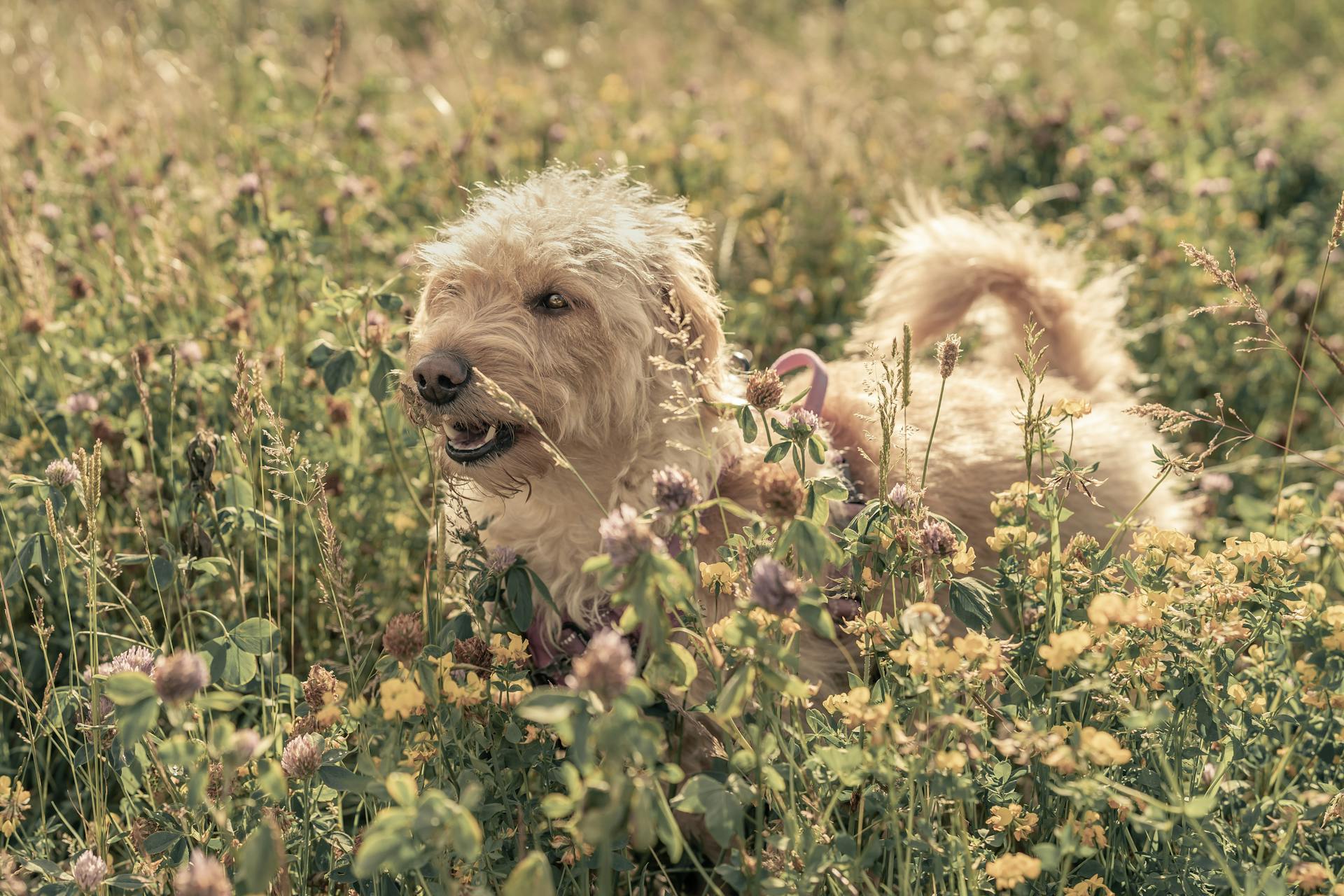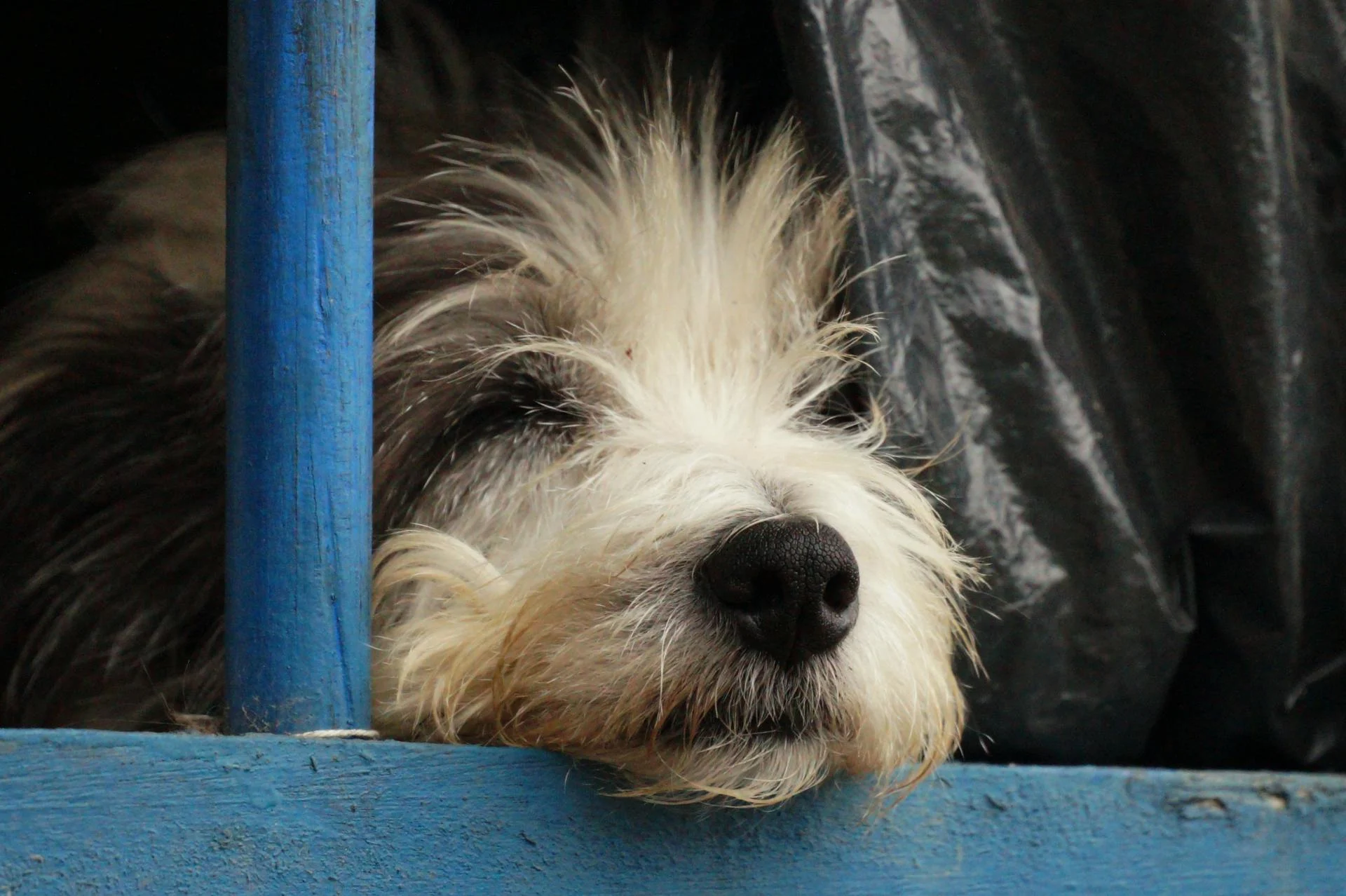
The Patterdale Terrier is a small, energetic dog breed that originated in England. They were bred to hunt small game like foxes and badgers.
Their compact size, typically weighing between 15-20 pounds, makes them perfect for families with small living spaces. They are also relatively low-maintenance when it comes to exercise, requiring daily walks but not extensive running or playtime.
Patterdale Terriers are known for their short, dense coats that require minimal grooming. They come in a variety of colors, including black, blue, liver, and tan.
You might like: Small Yorkshire Terrier
History and Origins
The Patterdale Terrier has a rich history that dates back to Northern England, where it was bred to control vermin that threatened sheep flocks. The breed was developed from the black, smooth-coated Fell Terrier, which was known for its toughness and ability to dispatch quarry.
Joe Bowman, a renowned breeder, is credited with creating the Patterdale Terrier by combining blue-black Border Terriers with Black and Tan Fell terriers. He aimed to produce a versatile, all-purpose terrier that could go to ground, hold off predators, and kill smaller quarry.
The original Patterdales had wire coats, but modern variations may have smooth or broken coats. The breed's development was a collaborative effort between Bowman, Cyril Breay, and Frank Buck, who shared the same objective of creating a useful working terrier.
Today, Patterdale Terriers are recognized by the United Kennel Club, which listed them in 1995. The breed has since spread across the UK and the US, where they're used for hunting and competing in dog sports like Barn Hunt and Terrier Racing.
Here's a brief overview of the breed's recognition by kennel clubs:
- United Kennel Club (US) - recognized in 1995
- ACA - American Canine Association
- ACR - American Canine Registry
- APRI - American Pet Registry, Inc.
- CKC - Continental Kennel Club
- DRA - Dog Registry of America, Inc.
- NKC - National Kennel Club
The Patterdale Terrier's origins are closely tied to the Fell Terrier, which was developed in Northern England to withstand harsh climates. These dogs were bred to hunt rats, foxes, and other vermin, and their small bodies allowed them to squeeze into tunnels and burrows to flush out game.
Physical Characteristics
The Patterdale Terrier is a sturdy and energetic breed with a distinctive physical appearance. Their wedge- or trapezoidal-shaped heads, triangular ears, and wide-set eyes make them easily recognizable.
Their strong and muscular legs support their athletic build, and their high-set tail is a key feature of the breed. In fact, the tail is often docked to a length of one-quarter to one-third of its original length, but it can also be left natural.
A Patterdale Terrier's coat can be smooth, broken, or rough, and it's always short and dense. They have three coat types, which can be further divided into smooth, broken, and rough, each with its own unique characteristics.
Check this out: Smooth Hair Fox Terrier
Head
The head of this breed is a strong and powerful feature, in balance with the size of the dog.
The head is wedge or trapezoidal shaped when viewed from the front.
A well-proportioned head is essential, with the length of the skull and the muzzle being equal or with the muzzle slightly shorter than the skull.
The muzzle should be strong, never appearing snipy or weak.
A good head should have good substance in the jowl and muzzle.
A unique perspective: Boston Terrier Skull
Forequarters
The forequarters of any animal are a crucial part of its overall physical structure. The shoulder is long, sloping and well laid back. This is a notable feature that sets it apart from other animals. The sloping shoulder allows for a more efficient use of space and movement.
Body
The body of a Patterdale Terrier is quite impressive. The body should be square or slightly longer than tall, measured from the point of the shoulder to the point of the buttocks, and from the withers to the ground.
This proportions-based measurement is key to understanding the breed's physical characteristics. The back is of moderate length and level, blending into a muscular, slightly arched loin that has slight to moderate tuck up.
The chest is a notable feature, being firm yet flexible, deep to the level of the elbow but moderate in width and oval in shape.
Hindquarters
The hindquarters of this breed are truly impressive, with strong and muscular bone structure.
This is matched by the angulation and musculature of the forequarters, creating a well-balanced overall appearance.
Tail
The tail is set high but not carried over the back. This is an important consideration for the breed's overall appearance and functionality.
If the tail is docked, only one-quarter to one-third should be removed. This is to ensure that the dog still has enough tail to use as a means of pulling itself out of a burrow.
There is no preference between docked or natural tails, so this decision is ultimately up to the owner.
Coat and Coloring
The Patterdale Terrier's coat is a defining feature of the breed, and it comes in three main types: smooth, broken, and rough. Each type has its own unique characteristics, but all three require minimal grooming to stay healthy.
A smooth coat is coarse, dense, and stiff, with no wave. Broken coats, on the other hand, have coarse, wiry guard hairs that are longer than those of the smooth coat type. Rough coats are coarse and longer than the other two types, and they always have facial furnishings.
On a similar theme: Rough Coat Border Collie

The Patterdale Terrier's coat colors are just as varied as their types. The standard colors include black, red, chocolate, grizzle, black and tan, and bronze. They can also be solid or have white markings on the chest and feet.
Here's a quick rundown of the Patterdale Terrier's coat types:
Regardless of coat type, the Patterdale Terrier's coat is relatively low-maintenance. A weekly brush should keep them looking their best, and they only need to be shampooed as needed.
For another approach, see: Yorkshire Terrier Coat
Physical Characteristics
The Patterdale Terrier has a distinct physical appearance that's shaped by its purpose as an earth-working terrier. Its wedge- or trapezoidal-shaped head, when viewed from the front, sets it apart from other breeds.
The eyes are set squarely in the skull and are fairly wide apart, making sure they don't protrude or bulge. This is crucial for a dog that needs to work underground.
Its legs are strong and muscular, and its tail sits high, but doesn't arch over the back. This is a deliberate design choice to help the dog navigate tight spaces.
The body should be square or slightly longer than tall, with a moderate-length back that blends into a muscular loin. The chest is firm yet flexible, deep to the level of the elbow but moderate in width and oval in shape.
The tail is set high but not carried over the back, and can be docked or natural. It should be strong but not overly thick.
The coat is coarse, dense, and stiff, falling back in place when lifted. It can be smooth, broken, or rough, and requires very little grooming to stay healthy.
Here's a breakdown of the three coat types:
The Patterdale Terrier comes in a variety of colors, including black, red, chocolate, grizzle, black and tan, and bronze, with or without white markings.
Highlights
Patterdale Terriers are small dogs, with an average weight of 15-35 pounds and a height of 9-15 inches. They have a short, dense coat that can be smooth, broken, or rough in texture.

Their coat comes in a variety of colors, including black, red, brown, and pied. You'll also notice that their coat can be quite coarse, especially when compared to other breeds.
Patterdale Terriers are relatively low-maintenance dogs when it comes to grooming. They only need to be brushed once a week to remove loose hair and distribute skin oils.
Here's a quick rundown of the Patterdale Terrier's physical characteristics:
Overall, the Patterdale Terrier is a sturdy and compact breed that's perfect for active families or individuals.
Personality and Temperament
Patterdale Terriers are all business and live for the opportunity to hunt small furry animals, making them a great fit for experienced pet parents who can provide the necessary guidance and attention.
They're extremely determined and clever, which can make them a handful if not properly trained. Positive reinforcement is recommended when training a Patterdale Terrier.
These social dogs thrive on interaction and can become destructive if left alone for long periods, so it's essential to provide them with plenty of attention and exercise. A secure, fenced yard is a must to keep them safe and prevent them from chasing neighborhood critters.
Patterdale Terriers are outgoing, lively, and fun-spirited, always keeping their owners on their toes. They're naturally energetic and need plenty of physical and mental stimulation to prevent boredom.
Early socialization is crucial to prevent fearfulness and reactivity towards strangers, and regular training sessions can help keep them engaged and focused. Short training sessions are recommended to keep them from losing interest.
Patterdale Terriers are excellent family pets, especially for active families with kids of all ages. They love to play and enjoy interactive toys, long walks, and games of fetch.
Health and Care
Patterdale Terriers are generally sturdy and healthy, but some may be prone to certain health issues. It's essential to maintain good care and regular veterinary checkups to detect any problems early.
Some common health problems Patterdale Terriers suffer from include dry skin, lens luxation, intervertebral disc disease, hypothyroidism, and hip dysplasia. Regular veterinary checkups can help detect these issues early on.
Take a look at this: Patterdale Terrier Health Problems
To keep your Patterdale Terrier's health in check, make sure to provide regular exercise, such as at least one 30-minute to 1-hour walk per day, with active play sessions and shorter walks mixed in. This will help prevent weight gain and keep your dog's energy levels in check.
Here are some common health issues to watch out for in your Patterdale Terrier:
- Dry skin: Check for dryness, flakiness, and irritation
- Lens luxation: Watch for signs of eye problems, such as redness, discharge, or squinting
- Intervertebral disc disease: Monitor for signs of back problems, such as limping, stiffness, or difficulty walking
- Hypothyroidism: Look for signs of weight gain, lethargy, or skin problems
- Hip dysplasia: Check for signs of hip problems, such as limping, stiffness, or difficulty walking
Regular grooming, such as brushing your Patterdale Terrier's teeth daily, can also help prevent periodontal disease and keep their coat in good condition.
Vet Rating
When it comes to your Patterdale Terrier's health and care, regular check-ups with your vet are crucial. Be sure to adhere to the schedule of examinations and vaccinations that your vet recommends.
Your Patterdale Terrier's diet and exercise routine are also vital to her health. Watch her diet and make sure she gets plenty of exercise to keep her happy and healthy.
Pet health insurance can help you cover the costs of medical tests and procedures your pet will need throughout her life. Signing up for pet health insurance is an important step in caring for your pet.
A Patterdale Terrier's grooming needs are moderate, with a rating of 2/5. This means she'll need regular brushing of her coat, but it's not a high-maintenance task.
If you're considering bringing a Patterdale Terrier into your family, be aware that they may not be the best fit for all households. They have a low rating of 1/5 for family-friendliness, which means they may not be suitable for young children.
Here's a breakdown of your Patterdale Terrier's vet rating:
Health and Care
Patterdale Terriers are generally sturdy and healthy, but some may be prone to health issues, which is why regular veterinary checkups are essential.
Dry skin is a common condition that can cause discomfort and irritation for your furry companion. Several factors can contribute to dry skin in dogs, and it's essential to address the underlying causes and provide appropriate care.
Your Patterdale Terrier's diet should be focused on high-quality food and a regular feeding schedule. Fresh water should be available at all times, and regular body condition scores should be conducted to ensure your dog is in ideal shape.
Additional reading: Crusty Scabs English Bulldog Skin Bumps

Patterdale Terriers are prone to weight gain, so make sure your dog gets at least one good half-hour- to hour-long walk per day with a few active play sessions and shorter walks mixed in.
To remove loose hair, brush your Patterdale's coat weekly with a slicker brush. Regular nail trims, ear cleanings, and the occasional bath are also necessary to maintain their grooming routine.
Here's a summary of common health issues in Patterdale Terriers:
- Dry skin
- Lens Luxation
- Inverterbral Disc Disease (IVDD)
- Hypothyroidism
- Hip Dysplasia
Keep an eye out for signs of ear infections, such as a pungent aroma or scratching/rubbing their ears. Regular ear cleanings can help prevent this.
To maintain your Patterdale Terrier's oral health, brush their teeth daily to prevent periodontal disease.
Frequently Asked Questions
What two breeds make a Patterdale Terrier?
The Patterdale Terrier's ancestry is uncertain, with possible origins from a cross between the Northumberland Pit terrier and the Old English terrier, or alternatively, the Fell terrier and the Border Terrier. Further research is needed to confirm its exact breed composition.
Do Patterdale Terriers bark a lot?
Patterdale Terriers are prone to barking, especially if left alone, and training from an early age is essential to manage this behavior.
Is a fell terrier the same as a Patterdale Terrier?
A fell terrier and a Patterdale Terrier are often used interchangeably, but technically, Patterdale Terrier is a specific breed developed from the fell terrier type. Both share a common ancestry, but have distinct characteristics.
What are Patterdale Terriers known for?
Patterdale Terriers are known for their exceptional hunting skills and loyal companionship, making them a versatile and valued breed. Originally bred for chasing foxes in rugged terrain, they possess a strong and determined nature.
What is another name for a Patterdale Terrier?
Another name for a Patterdale Terrier is the Fell Terrier. This name reflects their origins and history as a hunting breed.
Sources
- https://www.ukcdogs.com/patterdale-terrier
- https://www.purina.co.uk/find-a-pet/dog-breeds/patterdale-terrier
- https://www.wisdompanel.com/en-us/dog-breeds/patterdale-terrier
- https://dogtime.com/dog-breeds/patterdale-terrier
- https://www.thepethealthclinic.com/client-resources/breed-info/patterdale-terrier/
Featured Images: pexels.com

